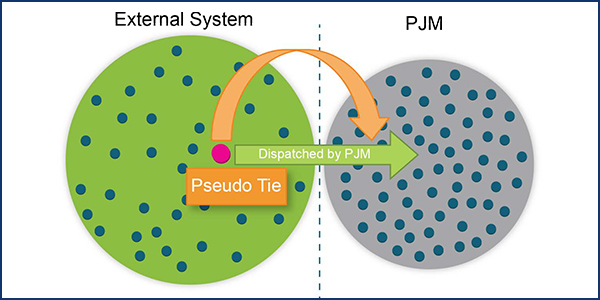By Michael Yoder
FERC on Friday rejected rehearing requests by American Municipal Power and Illinois Municipal Electric Agency over the commission’s November 2017 order approving PJM’s tougher requirements for pseudo-tied generators. The commission also approved PJM’s December 2017 compliance filing required by the order (ER17-1138).
“The commission found that PJM’s new pseudo-tie requirements would help ensure that external resources bidding into the PJM capacity auctions are comparable to internal resources in assuring that they will be deliverable to PJM’s system when needed,” FERC said last week. “With this principle in mind, we continue to find that PJM’s proposed treatment of pseudo-tied resources is just and reasonable.”
AMP’s Challenge
AMP’s rehearing request alleged five errors by the commission, including a challenge to PJM’s decision to set the electrical distance requirement at 0.065 per-unit impedance. AMP said the commission “failed to weigh and substantiate the impact of the proposed electrical distance requirement with the level of reliability assurance” and “failed to address the relationship between the value selected as the electrical distance requirement and the impact on PJM’s state estimator.”
PJM said the 0.065 threshold was based on a distribution factor analysis (DFAX) to identify the external facilities that would be impacted by PJM’s dispatch of external resources. PJM said the distance requirement made at least 130 GW of existing external resources in the Eastern and Midwestern U.S. eligible for pseudo-ties. The commission accepted PJM’s threshold, saying it was the “result of significant analysis and requiring PJM to rely on an external resource with a higher impedance value would increase the risk to PJM’s state estimator.”
The commission reiterated its previous finding that the electrical distance requirement was just and reasonable “because establishing a bright-line test for external participation strikes an appropriate balance between allowing external resources to participate in PJM’s capacity auctions, while providing PJM with a level of reliability assurances.”
IMEA’s Arguments
IMEA questioned FERC’s interpretation of Section 217(b) of the Federal Power Act and whether the commission’s decision “violated the sanctity of contracts.”
The agency argued that the commission’s determination that Section 217(b) of the FPA only applies to the energy markets and not capacity markets “effectively destroys the self-supply rights of load serving entities (LSEs).”
It said that if Section 217(b) does not apply to capacity markets, then PJM and other RTOs could make filings through Section 205 of the FPA to eliminate all “self-supply options” based on a finding that having control of all resources and planning would ensure better reliability.
FERC was unmoved. “Unlike energy markets, RTOs implement capacity markets to ensure long-term reliability and resource adequacy and, therefore, different requirements for using generation may be applied to capacity and energy markets,” the commission said.



